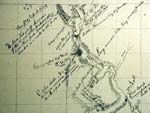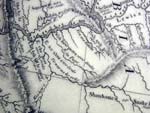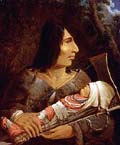 | | Lewis and Clark Map of Celilo Falls and the Dalles, ca. 1805 |
The detailed journal entries recorded by William Clark, Meriwether Lewis, Patrick Gass and Joseph Whitehouse offer tremendous insights into the peoples and natural habitats they encountered. This page summarizes a few of their observations as they traveled the Columbia River into the lands of the Tenino (Warm Springs) and Wasco bands. The entries begin while traveling down the Columbia River on October 21, 1805, in the vicinity of the John Day River, and continue until October 29. This page also includes references to the Corps of Discovery's return trip along the same route, from April 13 through April 23, 1806.
|
|
Margaret Suppah discusses the rich range of foods the people had and how they shared the roots and berries with Lewis and Clark. (Interviewed by Duran Bobb. October 2002) |
October 21, 1805 (and April 22 - 23, 1806 upon their return). Accompanied by their two Nez Perce guides, Twisted Hair and Tetoharsky, the Corps of Discovery observed large numbers of Indians in fishing-related activities along the river. On the northern bank of the Columbia, across from the mouth of the River la Page (also known as the John Day River), was a village of mat lodges of the Wah-how-pum people. They numbered some 700 Teninos (later referred to as Warm Springs), speaking a Sahaptin language, and, as described by William Clark, “all of whome have pierced noses and the men when Dressed ware a long taper’d piece of Shell or beed put through the nose.” It was on this day that the Corps first saw what they called, “Timm” or “Falls” Mountain, better known as Mt. Hood, a "Conocil mountain . . . covered in Snow.” One explanation offered by Clark on why so many of the villages were located on the north side of the river was out of fear of raids from the Snake Indians (likely Northern Paiute). As one of the Nez Perce guides pointed out, a great battle had occurred south of here “in which maney were killed on both Sides.”
|
|
Maxine Switzler relates how Lewis and Clark were "welcomed" by the Indians. (Interviewed by Brigette Whipple, October 2002) |
Upon their return trip upriver and unlike earlier accounts in his journals, Meriwether Lewis does report the people of the Wah-how-pun villages “much pleased to see us,” and at one camp reported smoking the pipe with the “old and brave men” and, followed with, “natives entertained us with a dance after their own method.”
|
|
Reggie Winishut disusses the difficulty Lewis and Clark had in navigating the falls and the route they took when they returned in 1806. (Interviewed by Duran Bobb. October 2002) |
 | | Lewis and Clark Map, ca. 1814 |
October 22 - 23 (and April 21 upon their return). Lewis and Clark came to “To-war-na-he-ooks River” (also known as the Towarnehiooks, Clark’s River or Deschutes River) and just below its mouth, the “Great Falls” (Celilo Falls). It was in this area the Corps of Discovery observed along the north shore of the river mat lodge villages of the E-nee-shur (spelled on various maps and journal entries as: E-ne-shuh, E-ne-chur or E-nee-sher) people, estimated to be some 1,200 Teninos, speaking a Sahaptian language. At this important trading center, Euro-American clothing and other trade items were very evident among the Indians. It was also evident that the two Nez Perce guides were showing increasing signs of fear and mistrust as the party approached The Dalles area, and the camp prepared for possible attack.
The Dalles area was an important dividing line between the Sahaptin-speaking peoples, such as the Tenino, Umatilla and Nez Perce, who lived upriver from the Dalles, and the Chinookan-speaking peoples, such as the Wasco, Wishram and Chinook, who lived down river from here.
|
|
Pat Courtney Gold considers the role of women and trade at the time of Lewis and Clark's arrival, and how they were misunderstood and not
fully appreciated by these American explorers. (Interviewed by Duran Bobb, July 8, 2003) |
Upon their return upriver from Fort Clatsop during April of 1806, there is a notable tone of mistrust and tension in the writings of Meriwether Lewis (from whom we had no entries while coming down river). He referred to the “stealing” and “unfriendly” nature of the Indians they were encountering. On April 21, after a “iron socket of a canoe pole” was discovered on the person of one of the Indians, Clark’s response was to give “him several severe blows.” Clark went on to warn the other Indians that he “had it in my power” to “kill them all and set fire to their houses” should there be any further attempts at stealing their property.
|
|
Pat Courtney Gold explains that the Wasco had already predicted the arrival of white people and the consequences of their coming. She also considers the type of foods eaten by the Corps of Discovery. Notice that during the interview Pat is weaving a "sally" bag. See Celebrating: Arts and Basketry. (Interviewed by Duran Bobb, July 8, 2003) |
 | | Mother and Child, Paul Kane Painting, ca. 1848. |
October 24 - 27 (and April 15 - 20 upon their return). As the Corps continued down from Celilo Falls they came to the Little Narrows and Long (Great) Narrows, with the E-skel-lute (spelled: E-che-loot, E-che-lute or Skil-lutes) people observed on the north shore. They resided in a village of some “21 large wooden (plank) houses sunk 6 feet into ground.” Clark estimated that there were some 600 E-skel-lute (Wishram/Wasco), who spoke a Chinookan language. Descriptions of one method of baking salmon and, upon their return trip upriver, a form of stick game and the First Salmon Ceremony (among the Wasco), were made. Clark also recorded the practice of flattening the heads of female children and many male children among the E-skel-lute. No longer able to speak the language and with apprehension in traveling into Wasco country, the two Nez Perce guides returned home. Nevertheless, Lewis and Clark were received “verry kindly,” and three separate formal peace meetings were held in which a pipe was smoked and peace medals given to the principle chiefs. The first meeting was held with the E-skel-lute, while the third was with the E-nee-shur (Tenino). It was unclear whether the second peace meeting was with a E-skel-lute or the E-nee-shur group. During part of this time period, the Corps camped at Fort Camp (Rock Fort) just west of The Dalles. A child of mixed Euro-American and Indian descent was also seen in one of the villages.
|
|
Adeline Miller discusses the time of the year when Lewis and Clark arrived and the biscuit roots that were shared with them. (Interviewed by Brigette Whipple. October 2002) |
October 28 - 29 (and April 13 - 14 upon their return). Continuing down from The Dalles, the Corps of Discovery came to a series of Chil-luck-kit-te-quaw (spelled: Chil-luck-kit-te-quaw or Chee-luc-it-to-quan) and Smock-Shop (Wishram-Wasco) villages of large wood-planked houses, speaking a Chinookan langauge. Clark estimated the Chil-luck-kit-te-quaw to be some “1,000 souls.” Considerable European trade items were observed, including “a British musket, a cutlash (cutless) and Several brass tea kittles.” By the 29th of October the Corps had departed from Wasco country as they headed west to the Great Rafio or Shutes, also known as the Cascades.
© Confederated Tribes of Warm Springs 2003
< previous | next >
|















